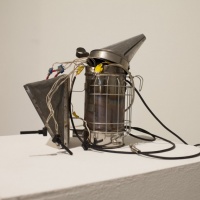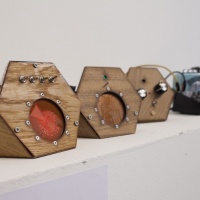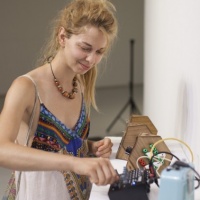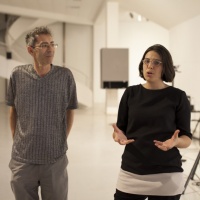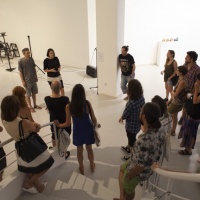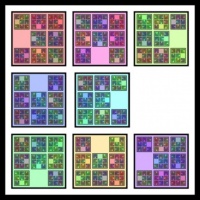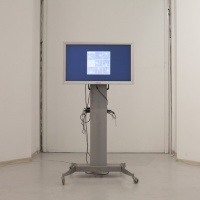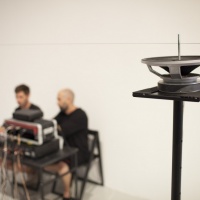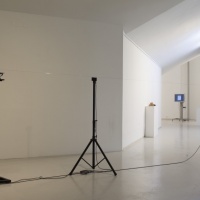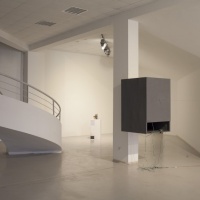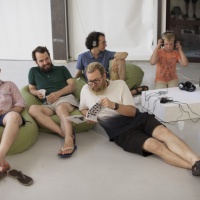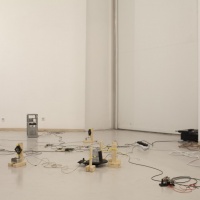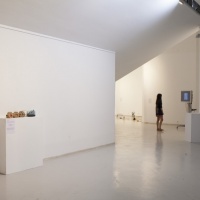Sounding DIY
live acts by Hrvoje Hiršl / Davor Branimir Vincze and Tin Dožić.
Monday-Saturday 10-13 h, 17-21 h
free entrance
The referential framework of the exhibition Sounding DIY relies on the so-called DIY culture (Do it Yourself), which emerged from the 1970’s as a reaction of the technological deployment. With influences of the underground vanguard movements, the handmade culture currently sets as an exponent of what is the free knowledge culture, read the open source and movements such as hacker and maker. The results of these practices involve an interdisciplinary connection between art, science, and technology that improves the creative aspects of contemporary cultural production. Moreover, sound art practices enrich the interconnection with music and engineering.
The exhibition pretends to highlight the DIY practices in front of the capitalist industry. Thus, represents an important change in the prototyping of musical instruments and sound objects that have effectively set as a primary creative impulse in our century. Sounding DIY works with artists in the field of handmade culture and promotes the efficiency of the results attained, either aesthetically and ideologically. Our goal is to highlight artistic creation through the development of new technologies and craftsmanship. Finally, Sounding DIY. fosters a community of tool developers and creative practitioners interested in supporting and understanding deep and sustained creative practice with technological tools.
Bioni Samp translates bee behaviors and sounds into electronic music to help raise awareness of the ecological issues threatening them. Electronic Beesmoker Hive Synthesiser is a found object (Beesmoker) with internal home-made 'Hive Synthesiser'. An updated version of 2009 version which originally acted as a modified breathe controller for MaxMSP patches. Now includes hardware home-made 'Bee' synth with 3 oscillators, emulating bees. In each honey bee colony there are three types of bee: drone, worker and queen bees. Each of these have their own individual frequencies in the following ranges: low – 200 Hz or less, mid – 200-400 Hz, and high – 400+ Hz, just like the earth has its own special frequency of approximately 9 Hz. The oscillators are capped roughly within these ranges.
Puzzle by Claude Heiland-Allen investigates in the history of puzzles. The 15-puzzle craze in 1880 offered a cash prize for a problem with no solution. In the Puzzle presented here the computer is manipulating the tiles. No malicious design, but insufficient specification means that no solution can be found; the automaton forever explores the state space but finds every way to position the tiles as good as the last... Each tile makes a sound, and each possible position has a processing effect associated with it. Part of the Puzzle is to watch and listen carefully, to see and hear and try to pick apart what it is that the computer is doing, to reverse-engineer the machinery inside from its outward appearance.
Noise Machine by Noise Orchestra is an evil space metal box electronic circuit, a no.3 in the series of noise machines that translate light into sounds using analogue electronics. Inspired by Russian sound artists of the 1920s (inc. Arseny Avraamov), we did a sound graphical residency at the National Media Museum last year where we played the collections and undertook a research trip to Moscow (noiseorchestra.org). The noise machines are constructivist sculptural objects in themselves, they will be made from metal and wood, here is a link to twitter post of a paper prototype. Noise Orchestra, is a collective formed by Vicky Clarke and Dave Birchall.
Songs for anthropocen #2 by Tin Dožić is based on the methods of media archeology and the reaproriation of obsolete technologies. The project explores the technological artifacts of the past. The sounds of rejected items, the specific quality of obsolete information records, electronic circuits, resonance materials become testimonies of the past and are used as raw material for audio compositions. Through the technique of contemplation, all of these materials create a new sound world - a hauntological landscape filled with himeras and ghosts of the near past. Objects taken from e-waste have been revived in the form of zombie media and brought into relation with digital samples.
Project Strings is a collaborative work of the media artist Hrvoje Hiršl and the composer Davor Branimir Vincze. This sound and media research freely interprets the connection between the string theory and Pythagoras’ harmonic theory by observing «microscopic» frequencies and phenomena originating from the sensitization of the extremely long string. When we say that a certain sound has the frequency of the middle A, that is 440Hz, one refers to its fundamental frequency.
Digital album Sounding D.i.Y. by elektronische-art-and-music, 2017 including artists: Dom Alle, David Bloor, Dirty Electronics, Jukka Hautamaki, Hrvoje Hiršl, Optonoise, Prolonged Version and Signal Noise.
About authors
Tin Dožić graduated psychology at the Croatian Studies of the University of Zagreb and new media at the Academy of Fine Arts in Zagreb. In his artistic practice, he takes the sound medium as a starting point and his fields of activity include field recordings, radio, experimental music, and installations. His work is based on the media research through the practice of developing his own electronic instruments, appropriation of outdated technologies and recycling. He performed and presented his work in different platforms in Croatia and abroad, independently and in collaborative projects (Test Lab @V2_ Rotterdam, CreArt @ LAVA Valladolid, Showroom of Contemporary Sound, MIMO, Sine Linea, Sound Art Incubator @Zagreb, Device art @Prague).
http://tindozic.space
Darko Fritz is an artist, independent curator and researcher. His work bridges over the
gulf between contemporary art, media art and network culture, taking up topics such as the glitch, error, and surveillance. Recently he has been developing horticultural units in public spaces. His curatorial work and research on New Tendencies and early computer art has earned international
acclaim with exhibitions at Neue Galerie Graz (2007) and ZKM (2009). 2002, he published "A Brief Overview of Media Art in Croatia (Since the 1960s)" and edited related database at the portal Culturenet. In 2010 he start the research "The beginning of digital arts in the Netherlands (1955 - 1980)", awarded by grants by Mondriaan Foundation, Amsterdam. Fritz is founder and programmer of the grey) (area - space for contemporary and media art since 2006.
http://darkofritz.net
Claude Heiland-Allen (aka ClaudiusMaximus) is an artist from London interested in exploring the complex emergent behaviour of simple systems. Working with and creating Free/Libre Open Source Software he hopes to become a better workman by building his own tools. Member of goto10. His projects include: ‘hsext’, for embedding Haskell inside Pure Data; ‘d0->d1->d2->d3->d4′, an audio visual performance exploring higher dimensions (realized with Pure Data + Gem + hsext); ‘dohpaintii’, a painting program with audible output (realized with Pure Data + GridFlow); and enhancing ‘ray4′, a 4D raytracer.
http://mathr.co.uk
Hrvoje Hiršl is an artist, Rresearcher and designer. His work is positioned between the discourse of contemporary and media art and the main themes range from the materiality of the art object
to the deconstruction of its aura and the boundaries of the media, and gradually turns to structures, automation and cybernetics. In 2012 nominated for Radoslav Putar Award for the best Croatian artist under 35. Recipient of the DordtYart Artists-in-Residence 2015 (Dordrecht) TRIBE Residency 2013 (Istanbul, Prague, Ljubljana) and Kulturkontakt Artists in Residence 2012 (Vienna). In 2012 participates in Documenta (13), Kassel, as part of the AND AND AND program. Nominated for the T-HT award 2012 and on the occasion of T-HT a -wards 2013 he is one of five artists personaly invited by the jury. One of the Croatian Representatives at the Design Biennale
in London in 2016. He is a member of AR.S (algoresearch.systems) research collective and founder of the I’MM_ Media Lab in Zagreb.
hrvojehirsl.com
Noise Orchestra are sound artists Vicky Clarke and David Birchall. They use light, DIY electronics, turntables and graphical scores to turn images and objects into NOISE; a process called graphical sound. Their practice operates at the intersection of art, experimental music and technology and manifests in performances, DIY instrument making, workshops and installations; all inspired by the photo-phonic principles of synthesizing sound from light. They have been developing a series of NOISE MACHINES that translate light into sound, these are synthesizer modules such as drone, delays and drum machines and exploring these as interdisciplinary performance instruments
https://noiseorchestra.org
Laura Plana Gracia is curator and researcher. Established in London since 2009. Has studied history of art and media art. Interested in electronic arts, art, science and technology and digital media. Participant at hacking culture, has taken part in many international events, such as exhibitions, workshops, conferences and concerts, in Spain, UK, Mexico, Colombia, Canada, Serbia, and Russia. Has collaborated with various institutions such as Fonoteca Nacional de Mexico, MACBA Museum of Contemporary Art Barcelona, CCCB Centre of Contemporary Culture Barcelona, MOTA Museum of Transitory Art, ISEA International Symposium of Electronic Arts. Has also developed work with the following festivals, ArtFutura, MUTEK, Alpha-ville. Has collaborated with the following artists, among many more, Locus Sonus, Scanner, Roy Ascott, Konrad Becker, Fran Illich, Milo Taylor, Arcangelo Constantini. Is attracted to show different disciplines, highlighting video art, net art, code art, software art, and sonic arts.
Bioni Samp is an artist, musician, inventor, beekeeper and video maker originally from Leeds, Yorkshire and currently resides in London. He studied ‘Art and Design’ at Wakefield District College. ‘Audio Visual Studies’ (Film, Video and Sound) at Farnham, West Surrey College of Art and Design (now University for the Creative Arts) and post-grad. ‘Electronic Imaging and Sound’ at Duncan of Jordanstone College of Art and Design, University of Dundee, Scotland. Bioni Samp’s first major installation was in 2013 at Barbican Arts Centre in London. His ‘Hive Synthesis’ 24 hour installation and performance was part of the Hack The Barbican Festival summer show.
https://bionisamp.wordpress.com
Davor Branimir Vincze is a versatile, intenationally active composer, winner of several awards and stipends in composition. Taken in account that he finished medicine prior to starting his musical career, it is evident why his music posesses the fascinating mixture of natural and social phenomena, mathematical curves, algorithms and electronics. Vincze is born in Zagreb, obtained his degrees in composition in Graz and Stuttgart, after which he finished practical training in electronic composition at Ircam in Paris. His pieces have been performed by ensembles such as Modern, Recherche, Intercontemporain, Talea and many others, in concerts and festivals such as Impuls, MATA, Manifeste, Biennale Zagreb, etc. In 2014 he has started Novalis, contemporary music festival in Croatia. Currently he lives in the US, where he's doing his PhD in composition with Brian Ferneyhough at Stanford University.


